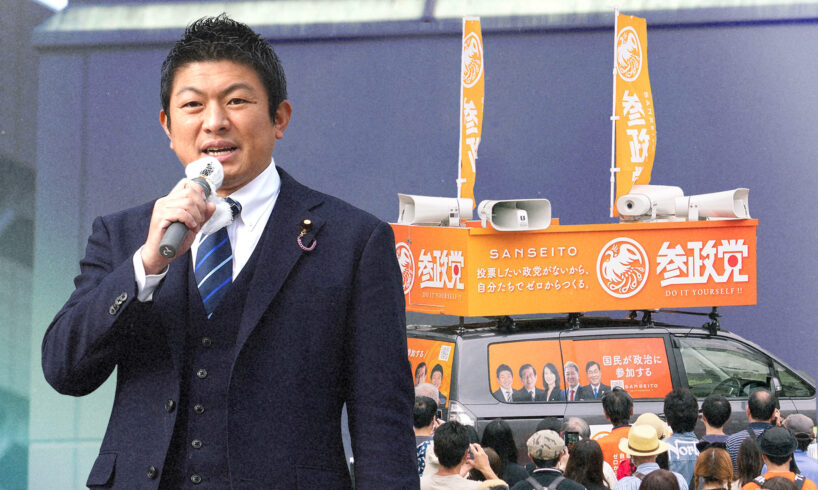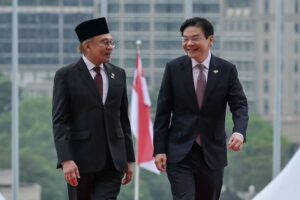
As Japan heads into another upper house election, an unexpected political force is gaining ground — and raising alarm bells. Sanseito, a once-obscure party known for its nationalist slogans and conspiratorial rhetoric, is polling unexpectedly high in national surveys.
In a recent Kyodo News poll conducted from July 5–6, the party ranked second in proportional representation support, behind only the ruling Liberal Democratic Party (LDP). For a group that was initially dismissed as fringe, the rise is both dramatic and deeply concerning to many observers.
With rhetoric that echoes Trumpism and European ultranationalism, it has become the most talked-about — and most unsettling — dark horse in Japanese politics.
What Is Sanseito?
Founded in early 2020, as the COVID-19 pandemic was beginning to unfold, Sanseito initially gained attention for its divisive and inflammatory rhetoric, as well as its penchant for repeating conspiracy theories. The party vehemently opposed mask mandates, PCR testing, vaccine requirements and other public health measures and was openly anti-immigration.
Its official platform prioritizes three pillars: education reform, health and food sovereignty and national defense. These seemingly innocuous issues conceal a far more disturbing worldview — a platform revolving around a hardline rejection of globalism and foreign influence. Under the banner of “Japanese First,” the party pushes for sweeping immigration restrictions, strict limits on foreign land ownership and policies that frame outsiders as a threat to national security and cultural purity.
Sanseito leaders reject internationalism, certain aspects of mainstream medicine, gender equality policies and what they see as the moral decay brought on by Western liberalism. Their COVID-19 stance was an early example of this strategy — their rhetoric at the time mixed pandemic denialism, anti-vaccine messaging and claims that global elites are using medicine and processed food to weaken Japan.
Sohei Kamiya and the Sanseito Party Logo | Wikimedia
Sohei Kamiya: Sanseito’s Conspiracy-Touting Figurehead
Like many nascent far-right movements, Sanseito has a charismatic figurehead known for divisive and conspiratorial outbursts: Sohei Kamiya, who was elected to the Diet’s upper house, the House of Councillors, in 2022 on the party’s proportional representation ticket. In the past few years, he’s blamed gender equality for Japan’s birthrate, dismissed older women as biologically irrelevant and spewed blatant anti-Semitism, to name a few.
Before emerging as the head of Sanseito, Kamiya had a brief and largely unremarkable stint in mainstream politics, including a term on the city council for Suita, which is located in Osaka Prefecture, and an unsuccessful run as an LDP candidate in 2012. After his failed candidacy, he created a YouTube channel called Channel Grand Strategy, which quickly gained a following for its hardline nationalist content and conspiratorial tone.
Through his channel, Kamiya positioned himself as a bold truth-teller railing against globalization, feminism, foreign influence and Japan’s political elite. By 2020, he had amassed thousands of followers — followers who would become supporters when he and a group of fellow right-wingers formally founded Sanseito in April 2020.
From the outset, Sanseito leaned heavily on YouTube and social media. This remains a core part of its strategy and appeal. The party’s online presence serves as both a megaphone and a funnel: Free videos and livestreams draw in viewers with health tips, anti-vaccine rhetoric and nationalist talking points, but the “real truth” is always said to be hidden behind paywalls. Followers are encouraged to become paying members — at rates far higher than those of traditional Japanese parties — in order to access members-only content, daily updates, regional chat groups and even “leadership training.” While the Liberal Democratic Party charges around ¥4,000 for a year, Sanseito demands ¥1,000 per month for regular membership and ¥2,500 for premium access.
This model accomplishes two things simultaneously. First, it creates a tight-knit ideological echo chamber, giving members a sense of belonging and insider knowledge while isolating them from outside criticism. Second, it generates significant revenue. These membership fees, multiplied across tens of thousands of recruits, have built a war chest that outpaces even established parties, all while maintaining the illusion of grassroots legitimacy.
Behind Its Sudden Rise
There are several factors behind the rise of Sanseito, many of them familiar-feeling to those who’ve watched far-right movements mobilize overseas. For decades, Japan’s stagnant wages, aging population and growing inequality have bred quiet despair. Conventional parties like the Liberal Democratic Party (LDP) and the Constitutional Democratic Party (CDP) are widely viewed as corrupt, stale and incapable of offering real change. Into this void stepped Sanseito.
According to international political analyst Yuya Watase, a Sanseito founding member who left the party after becoming disillusioned with its policies, the party’s success stems from doing what no other party in Japan bothers to do: actually building a membership base.
In essence, Sanseito mirrors the populist playbooks seen elsewhere: Trump’s Republican Party, Brexit-era UKIP and France’s National Rally. The ideological content varies, but the mechanics — direct communication, emotional narrative and institutional distrust — are strikingly similar.
How Japan Is Reacting to Sanseito
Sanseito’s rise has triggered a wave of nervousness across Japan. Eight major human rights NGOs, including Solidarity Network with Migrants Japan, issued a joint statement condemning Sanseito’s slogan “Japanese First” as hate speech. The statement warned that exclusivist politics, which view “foreign nationals and people of foreign origin as enemies,” are rapidly spreading through society. Over 260 signatories have since signed in solidarity. Public pushback is growing in more creative forms, too. In Shinjuku, activists recently held a protest “rave against racism,” where chants of “don’t vote for Sanseito!” rose from the crowd.
For now, Sanseito’s presence is limited: As of July 2025, it holds just two seats in the 248-member House of Councillors, three in the 465-member House of Representatives and three in the 127-member Tokyo Metropolitan Assembly. Its influence, however, is outsized. The party has shown it doesn’t need major representation to shape the political conversation and has, indeed, seen over 140 members elected to prefectural and municipal assemblies.
The threat isn’t that Sanseito will take control of the Diet overnight; it’s that the party is gradually redrawing the boundaries of what’s politically acceptable — what can be said, proposed and believed. Its real impact lies in the way its worldview bleeds into the mainstream. And this isn’t just about one party. Sanseito didn’t emerge in isolation, and its rise may embolden members of larger parties to echo more hardline, nationalist positions. Already, we’ve seen a shift: mainstream politicians hardening their stance on immigration, leaning into rhetoric around “traditional values” and “Japanese uniqueness.” What once sounded fringe is becoming part of the debate.
Japan is not immune to the forces behind Trumpism, Brexit or the rise of Le Pen. Sanseito is a reflection of that. The question now is whether Japan’s civil society, media and institutions are ready to respond before these shifts become entrenched.





